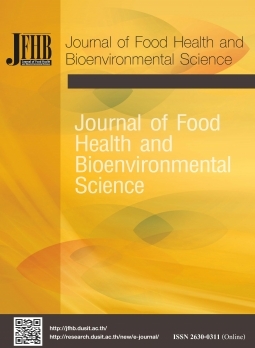Preparation, Characterization and Evaluation of Octyl Methoxycinnamate (OMC)-Loaded Solid Lipid Nanoparticles (SLNs) by Using a Microemulsion Technique
Keywords:
Solid lipid nanoparticles (SLNs), Microemulsions, Octyl methoxycinnamate (OMC)Abstract
This research prepared the solid lipid nanoparticles (SLNs) based on microemulsion to load octyl methoxycinnamate (OMC) as a UV absorber for instability protection. The optimal microemulsion formulation was selected by visual assessment according to a transparent and thermodynamically system form. The optimal microemulsion obtained from the experiment composed of 10% w/w glyceryl monostearate (GMS, solid lipid), 10% w/w Tween 80 (surfactant), 15% w/w PEG-40 hydrogenated castor oil (surfactant) and 20% w/w ethanol (co-surfactant). Various processing parameters for the preparation of SLN was carried out using three factors including, 1) warm microemulsion (mL) and iced water ratio (mL), 2) homogenization speed (rpm) and 3) homogenization time (min) and two responses assessed were particle size and polydispersity index (PDI) to obtain a SLNs batch with smaller particle size and optimum PDI. The OMC-loaded SLN had 693.07± 0.05 nm mean particle size and 0.56±0.04 PDI, prepared by optimal processing parameters. The surface morphology of the SLNs was assessed by transmission electron microscopy (TEM), the result found that OMC-loaded SLN showed a smooth surface and spherical shape. Entrapment efficiency of OMC-loaded SLN was found to be 99.89±0.020% . The stability testing of the prepared SLN was studied. Result found that OMC-loaded SLN showed slightly lower stable compared with the initial condition. All obtained results indicated that this method and processing parameters can prepare the SLNs which was suitable for cosmetic application.
References
Andreani, T., Dias-Ferreira, J., Fangueiro, J.F., Souza, A.L.R., Kiill, C.P., Gremião, M.P.D., ... Souto, E.B. (2020). Formulating octyl methoxycinnamate in hybrid lipid-silica nanoparticles: An innovative approach for UV skin protection. Heliyon, 6(5), e03831.
Andréo-Filho, N., Bim, A.V.K., Kaneko, T.M., Kitice, N.A., Haridass, I.N., Abd, E., ... Leite-Silva, V.R. (2018). Development and evaluation of lipid nanoparticles containing natural botanical oil for sun protection: characterization and in vitro and in vivo human skin permeation and toxicity. Skin Pharmacology and Physiology, 31, 1-9.
Butt, S.T., & Christensen, T. (2001). Toxicity and phototoxicity of chemical sun filter. Radiation Protection Dosimetry, 91, 283-286.
Caboi, F., Lazzari, P., Pani, L., & Monduzzi, M. (2005). Effect of 1-butanol on the microstructure of lecithin/water/ tripalmitin system. Chemistry and Physics of Lipids, 135, 147-156.
Farboud, E.S., Nasrollahi, S.A., & Tabbakhi, Z. (2011). Novel formulation and evaluation of a Q10-loaded solid lipid nanoparticle cream: In vitro and in vivo studies. International Journal of Nanomedicine, 6, 611-617.
Gasco, M.R. (1993). Method for producing solid lipid microspheres having a narrow size distribution. United States Patent, USS 188837.
Gasco, M.R. (1997). Solid lipid nanospheres from warm micro-emulsions. Pharmaceutical Technology Europe, 9, 52-58.
Gromkowska-Kępka, K.J., Puścion-Jakubik, A., Markiewicz- Żukowska, R., & Socha, K. (2021). The impact of ultraviolet radiation on skin photoaging- review of in vitro studies. Journal of Cosmetic Dermatology, 20, 3427-3431.
Liu, XH., Liang, X.Z., Fang, X., & Wan-Ping, Z. (2015). Preparation and evaluation of novel octylmethoxycinnamate loaded solid lipid nanoparticles. International Journal of Cosmetic Science, 37, 446-453.
Mulla, J.A., Suresh, S., & Khazi, I.A. (2009). Formulation, characterization and in vitro evaluation of methotrexate solid lipid nanoparticles. Research Journal of Pharmacy and Technology, 2, 685-689.
Olbrich, C., & Muller, R.H. (1999). Enzymatic degradation of SLN-effect of surfactant and surfactant mixtures. International Journal of Pharmaceutics, 180, 31-39.
Prombutara, P., Kulwatthanasal, Y., Supaka, N., & Sramala, I. (2012). Production of nisin-loaded solid lipid nanoparticles for sustained antimicrobial activity. Food Control, 24, 184-190.
Radaic, A., de Paula, E., & de Jesus, M.B. (2014). Factorial design and development of solid lipid nanoparticles (SLN) for gene delivery. Journal of Nanoscience and Nanotechnology, 14, 1-8.
Ramteke, K.H., Joshi, S.A., & Dhole, S.N. (2012). Solid lipid nanoparticle: A review. IOSR Journal of Pharmacy, 2, 34-44.
Ratcharin, N., Wongtrakul, P, & Indranupakorn, R. (2012). Preparation of Zingiber Officinale extract loaded solid lipid nanoparticles. Advanced Materials Research, 506, 389-392.
Sastri, K.T., Radha, G.V., Pidikiti, S., & Vajjhala, P. (2020). Solid lipid nanoparticles: Preparation techniques, their characterization, and an update on recent studies. Journal of Applied Pharmaceutical Science, 10, 126-141.
Shah, K.A., Joshi, M.D., & Patravale, V.B. (2009). Biocompatible microemulsions for fabrication of glyceryl monostearate solid lipid nanoparticles (SLN) of tretinoin. Journal of Biomedical Nanotechnology, 5, 396-400.
Xia, Q., Saupe, A., Müller, R.H., & Souto, E.B. (2007). Nanostructured lipid carriers as novel carrier for sunscreen formulations. International Journal of Cosmetic Science, 29, 473-482.
Xu, C., Zeng, X., Yang, Z., & Ji, H. (2021). Sunscreen enhancement of octyl methoxycinnamate microcapsules by using two biopolymers as wall material. Polymers, 13, 866.
Yingngam, Y., Phimpanit, Y., Wongkasemchai, N., Sila-On, W., & Rungseevijitprapa, W. (2007). Encapsulation of rice bran oil in solid lipid nanoparticles (SLN) for skin hydration and viscoelasticity. Isan Journal of Pharmaceutical Sciences, 3, 8-22.
Young, A.R., Claveau, J., & Rossi, A.B. (2017). Ultraviolet radiation and the skin: Photobiology and sunscreen photoprotection. Journal of the American Academy of Dermatology, 76, S100-S109.
Downloads
Published
How to Cite
Issue
Section
License

This work is licensed under a Creative Commons Attribution-NonCommercial-NoDerivatives 4.0 International License.








